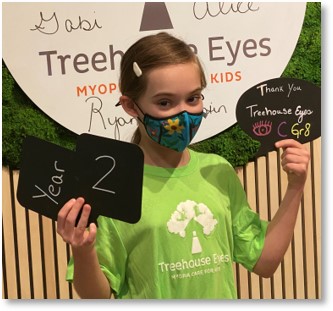3 Facts About Myopia You Should Know
Given the rapid increase in childhood myopia being seen in the U.S., the American Academy of Ophthalmology and American Academy of Pediatrics recently updated their guidance on managing myopia in children.
 Both organizations now recommend children play outdoors more to delay the onset of myopia and support proactive treatment of myopic children to reduce the progression and eye disease risk associated with higher myopia later in life.
Both organizations now recommend children play outdoors more to delay the onset of myopia and support proactive treatment of myopic children to reduce the progression and eye disease risk associated with higher myopia later in life.
What is Myopia?
Myopia is a disease where the eye grows too long, resulting in blurry distance vision and increased risks of serious, sight-threatening eye diseases, such as glaucoma1, cataract2, or retinal eye diseases3. An estimated 1 in 3 children in the U.S. have myopia and the prevalence has grown dramatically over the last 30 years4. Research has shown lack of outdoor time for kids and more near work, like reading and time on screens, drive the massive increase we are seeing in myopia5-7.
Myopia Progresses As Your Child Grows
Myopia generally begins in childhood and progresses throughout the school-age years, usually stabilizing into the late teens.
Because the eye grows in tandem with the body, it’s only natural that it stops elongating once the rest of the body stops growing in early adulthood. This also means there may be times in a child’s development where they experience growth spurts and suddenly require a higher prescription. There are ways to effectively treat myopia in order to prevent it from progressing as the child grows. Slowing myopia early on can make all the difference to your child’s eye health as they age.
Natural Sunlight Can Help
Myopia incidence is rising in kids. Less time spent outdoors and more time on near work such as reading and device use has led to higher instances of myopia. This is a global phenomenon that is most acute in developed countries, and current estimates state half the world’s population will be myopic by 2050.
In fact, a recent study found that increased exposure to outdoor light reduces myopia development.
There Are Now Treatments for Myopia
There is hope for parents is there are several treatments now available that can slow or even stop the progression of myopia in children. These treatments, usually involving a customized contact lens or prescription eye drops, are proven to slow down the elongation of the eye so a child’s vision does not deteriorate as quickly. Parents should talk to their eye doctor about their child’s risk for myopia and if their child is a good candidate for treatment.
You can prevent serious, sight-robbing eye diseases by scheduling your child’s myopia consultation with us today. Visit {Please add the practice name, scheduler link, and phone number to this section prior to posting} Help your child’s quality of life improve before your eyes!
References: